May 2019
The Hippos Showed Some Snout
Finding our own delta experience in Botswana and Namibia
From time to time, not as often as we might like, but sometimes, the stars align and we find ourselves settled in a spot that can only be described as… perfect. That is where we are this morning.

The sky is clear and blue with a cooling breeze nearly constant. We’re parked in a way that keeps the sun behind us from sunrise to sunset with the changing light bathing the scene outside our door in just the right way. We are alone. No traffic, no other campers, no internet or phone, no lights or sounds but our own; nothing at all but us, the water and the reeds of the riverbank, the birds walking on the lily pads, the grazing impala and wildebeest across the way, troops of monkeys and baboons taking turns making their rounds and a family of hippos in the water beside us; sleeping, feeding and occasionally snorting their distinctive call. One afternoon a group of elephants crossed the river a short distance away.
Heaven.
So where are we and how did we come to be here? Ah, therein lies the tale we hope to share with you…
* * * * *
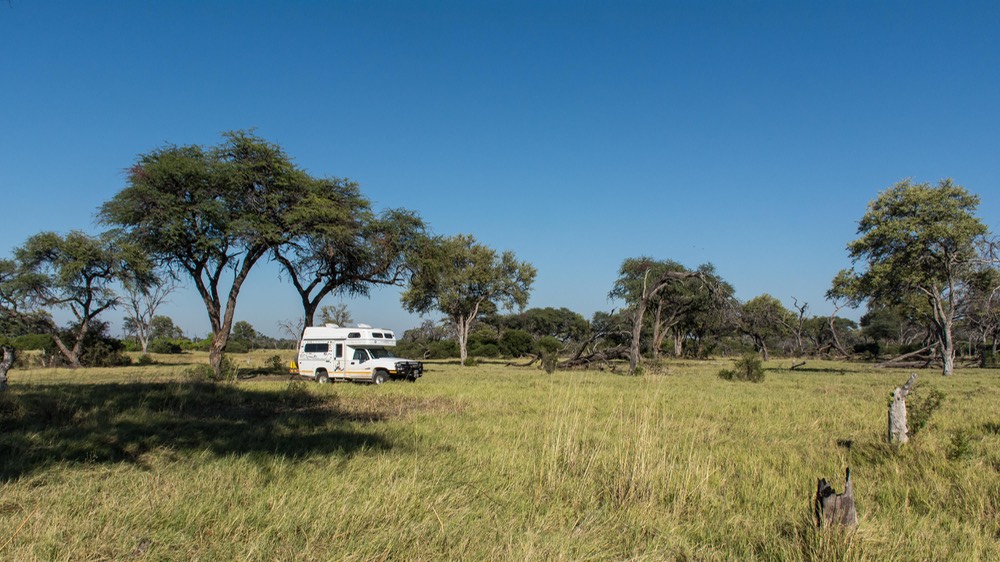
When last we wrote, we were about to leave South Africa and enter Botswana. Usually when we are leaving a country that has become familiar to us and going to a new one we have mixed feelings; excitement at the experiences that await us, but also concerns about what will be different. Coming to Botswana was like that. We knew there was a lot here to see and enjoy, but we also knew that in some ways it would be a more difficult country for us and perhaps not as user-friendly as the countries we’ve become familiar with in our nearly nine months in Africa. Among other things we knew that in many ways Botswana would be a more expensive country for us, and that is always an issue.
So, we’d been focusing our planning on looking at how we could enjoy Botswana in a way that would be affordable, not causing us to burn through too many Pula every day. The Pula is the official currency of Botswana, and, unlike Namibia and Lesotho and Swaziland, it isn’t tied to the ZAR, the South Africa Rand. It stands alone. If you don’t have any Pula, they’ll take your Rand, but you won’t get a great rate of exchange. And you’ll be spending a lot of Pulas when you visit Botswana, so be sure to stop at the first ATM you find and get a handful.
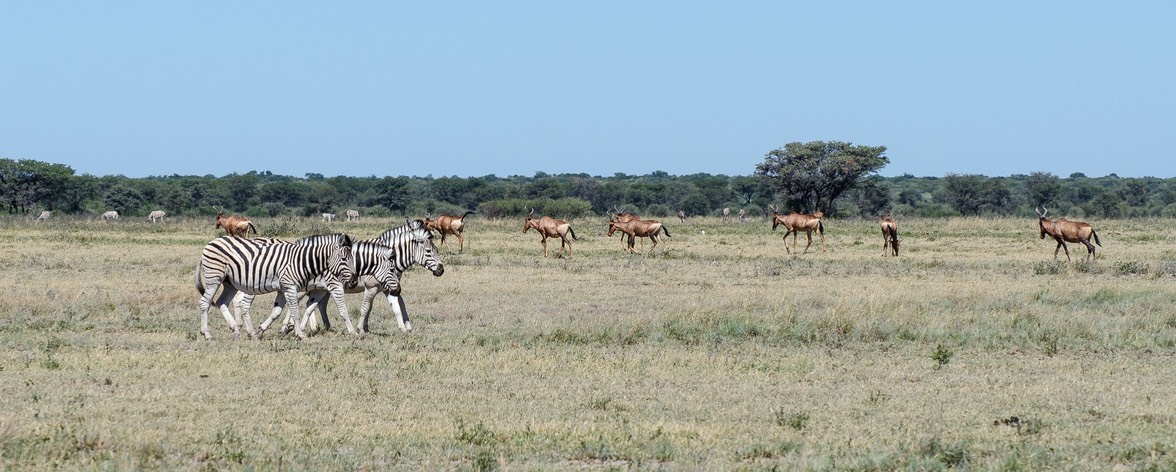
This is all by way of telling you that when we crossed into Botswana, we had a plan in mind that had us first heading for the (very rewarding) Khama Rhino Sanctuary, about halfway up the eastern part of the country. We’d heard that it was a great spot for observing white rhinos (along with the occasional black), and we think rhinos are pretty cool. Back in the day, before the late 90’s when the Sanctuary was established, this spot had once been full of wildlife but had been decimated over time by farming and hunting. Some local folks knew that this could be a good spot for the animals again so, with governmental help, they formed a conservation group and started to make it happen.

There are lots of different kinds of wildlife here, but the area is perfect for rhinos, so a small group of them was transferred here from other parks; they’ve thrived and grown and the herd currently numbers about fifty. The large property is fenced and the animals are protected by 24-hour surveillance but otherwise ignored. Everyone is happy.

Much of Botswana is desert, the Kalahari, and the Sanctuary is well out into the sand. Although it has the support of the government, it is a local community project, which we think is really great. When you go there, you are being helped by locals, and talking with them about what’s going on in their neighborhood. It’s a low-key place, with a small rustic campground and reasonable entry and camping fees; the focus is on the animals; protecting them but still keeping them accessible to visitors. Our kind of place for sure.
We had a good time. We saw one huge beast lying under a tree in the shade, and later had the good fortune of spotting a mother and juvenile crossing the open plain; we spent almost an hour tracking them along as they wandered through the brush, visited a waterhole, and then meandered along in the sand checking out the grasses and pooping their way across the open pan. We kept our distance, but still were able to move the Tiger — our portable hide — around on the road system of the park and watch them pretty closely. It was one of our best experiences in Botswana. In addition to the rhinos we also saw several giraffe and many zebras, wildebeest, impalas and red hartebeest. It was a good day.

Moving on from the Khama Rhino Sanctuary, we traveled on good road up to Francistown, our first chance in Botswana to get a SIM card and internet access, as we’d entered the country on a Saturday and businesses were closed in the first couple of towns we’d passed. From there we drove further north to the Nata Bird Sanctuary, where we had a nice evening enjoying the birds, and a quiet night in a deserted little local campsite. In rhino country we hadn’t noticed it so much, but at Nata it was obvious — it had been a dry year, with little or no rain, and the birds and animals in the parks were already needing to travel long distances to get to water.
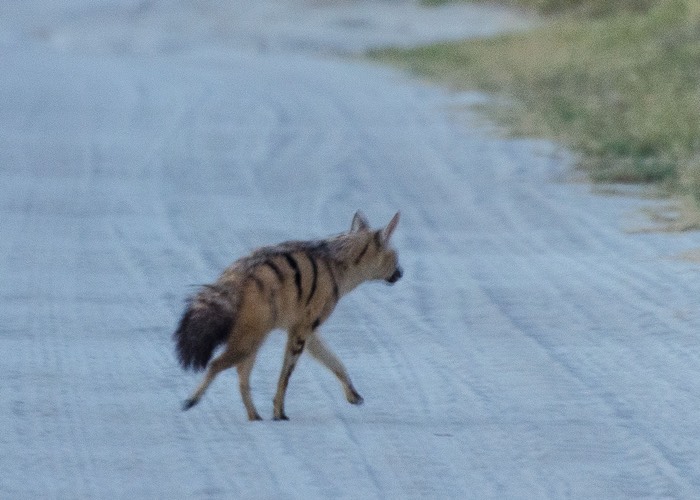
May is normally considered to be early in the dry season and that is why we’d timed our visit for now: before the high season crowds, but after the roads had become passable. Well, this year it seems much of the area already looks more like September than May. Here at Nata, many of the birds had migrated on, and those still around were far, far away from where we could get access in order to see them. We had a good time regardless, but could not see much of the flamingos and pelicans we had come for.
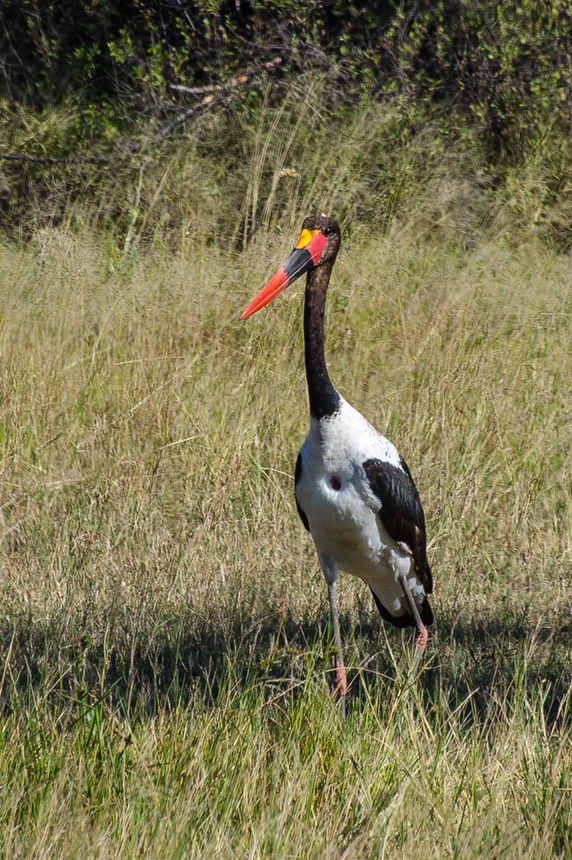
We did, however, on a post-sunset drive back to the camp site from the pan, have a most fortunate sighting. A rare, hard to find, nocturnal (three reasons right there why we usually would never see one) Aardwolf popped his head up on one side of the road and casually sauntered right across in front of us. The photo is fuzzy (just like the Aardwolf, now that you mention it), but fully recognizable. Cool! We tell ourselves we might not have seen him if things were as wet as normal.
Before we move on any further, we’ll tell you a bit about the plans we’ve evolved for Botswana, because a visit here comes with certain strings attached. Many countries in Africa must rely on tourism as a large portion of their economy; disappointingly, Botswana is one of several that has chosen to go in a direction that tries to maximize the dollar return per visitor. There’s a lot to offer the visitor here, much of it having to do with wild animals, but instead of making the attractions available to and affordable by many, the country has decided instead to control the number of visitors by making all activities both very expensive and also hard to do as an independent traveler. The government makes its money by leasing out space or issuing licenses for private lodges and safari companies. Then, the companies are free to charge whatever the market will bear, which is quite a lot it seems. This places the emphasis on the fly-in, package tourist and minimizes accessibility for others.
Most tourists come in on a pre-arranged visit to several of the most well-known sights. Every part of it is expensive, but it’s a package and already paid for in advance so the individual costs aren’t as much of a factor. And they have a really good time.

Just ask them. “Quick, quick, what’s your favorite country in Africa?” “Well, we really enjoyed South Africa… and Namibia… and, of course Swaziland is cool; but Botswana — that’s the best!”
As independent travelers, on a budget, we’ve tried to decide what’s important to us, and what’s just on someone’s list of “must do” places if you are visiting Africa. For us, in Botswana it quickly became a short list, one that features more community-based activities, more spots sort of on the fringes and far fewer national parks. Just seeing animals in the wild has always been higher on the list for us than going to curio shops, bungee jumping and safari drives to see the “Big 5.” Fortunately we’d already seen lots of animals, long since, in more affordable South Africa; so we did not feel any pressure to go to just the ‘right’ places for the ‘best’ sightings.
What we really wanted was to be able to spend some time in the Okavango Delta, because it’s something unique and unlike other places we’ll be visiting in Africa. In this country, if it isn’t desert, it’s delta and we’ve already seen plenty of desert. The Delta is special; it covers an enormous part of the upper half of Botswana. It’s the largest inland delta in the world. And it’s filled, absolutely filled, with wild animals. And they aren’t fenced. They are free to wander. So, how do you see this Delta and its critters? We intended to figure it out.

Visiting the delta first of all depends a lot on the time of the year, and also how the rainy season went. The water that fills the area during and after the rainy season comes down from Angola. It brings tremendous wet; and then it gradually sinks into the sands and mostly disappears while the land around it dries out. Road access to the delta is very limited and is seasonal at best.
So for the most part, you cannot drive into much of this enormous area; if you want to see it, and see the animals that are luxuriating in all the green grass and wetness, you must fly in. You fly to lodges on islands of higher ground and then take boat tours and guided game drives and walks out to explore the area around. This can surely make for a wonderful experience, but is too costly for us to consider.
If you wait for later in the year, when the rains have passed by and the ground is drying out, things become a bit more accessible although still very difficult. It would require a more capable truck than ours, and certainly one with a more capable and adventurous crew than our Tiger enjoys. For instance, on the northeast corner of the delta is Moremi National Park and it does have accessible campgrounds in the drier parts of the year, but the costs are still high.
For Rick and Kathy this wasn’t the plan we wanted to make; we needed to find a different path. In doing our research we had noticed in someone’s account of their time here that, facing the same constraints as ourselves, they had discovered an area we could drive to that would be a simpler and more affordable option for us — the Khwai River Conservation Area. This area seemed to be not nearly as high-priced as much of what we had learned about. We investigated, we visited, and we were captivated. Too cool.
This spot seemed perfect for our needs. It is a smallish plot on the eastern side of the Delta; it borders the northern edge of Moremi NP, and is on the southern edge of even more famous Chobe National Park. We had found out that the area is managed by a local conservation group. It’s low-key, quiet, and while expensive for us, more reasonable than most anything else around. It was on the high side of what we were willing to pay, but only half of the fees in Moremi, and even less than half of Chobe’s cost. Even better, folks said there are more animals here then at Moremi, and you can easily access them. We were sold.
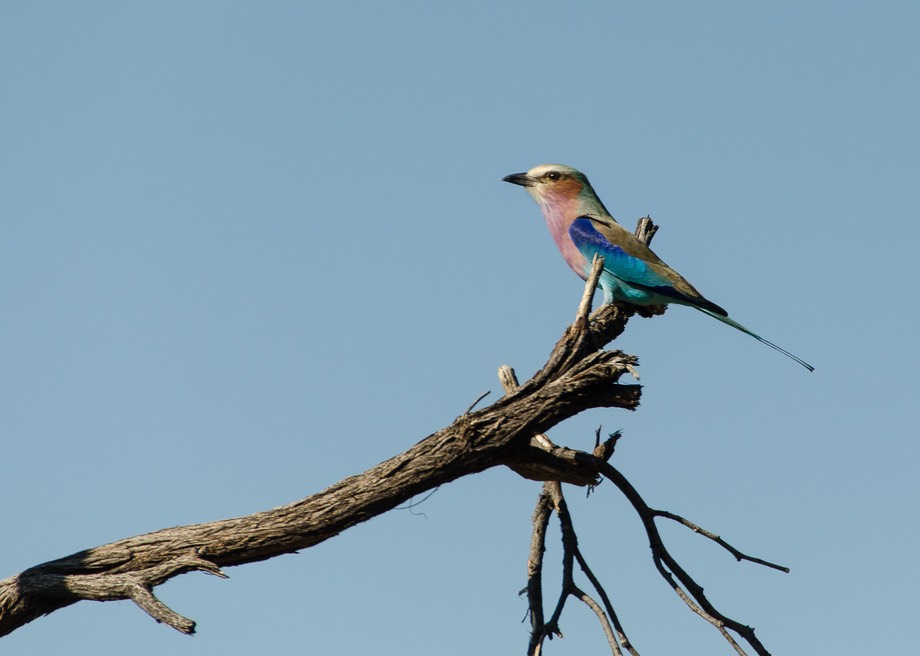
So — our adventures at the Khwai River Conservation Area first involved getting there. In the Delta, the world starts and stops with the town of Maun. (No, not like “monumental”; like “Mound” but without the ‘d’.) Regardless of where you want to go, or what you want to do, you start at Maun. Which is on the southeast side of the Delta, and sort of in the middle of the country.
So, figuring all this out, we left Nata and took off to the west, driving on the only road across this part of the country, heading to Maun. Along the way, we made a bit of a stop at a funky spot called Planet Baobab. Aha! we said. Baobabs! Aren’t they close cousins of the Boab trees we’d seen in Australia? Yup. So we stopped and took a few pictures and enjoyed visiting some cousins of old friends.
On arrival in Maun, we began working on finding answers and opportunities to see the area and enjoy the animals that apparently surrounded us. With a certain amount of difficulty we located the appropriate office, fortunately right next door to the main Botswana Tourist office in town, and paid our entry and camping fees for two nights at Khwai River. We were lucky to find the office early enough in the day because, it being Saturday, they were closing at 12:30 and we finished up with only about ten minutes to spare.
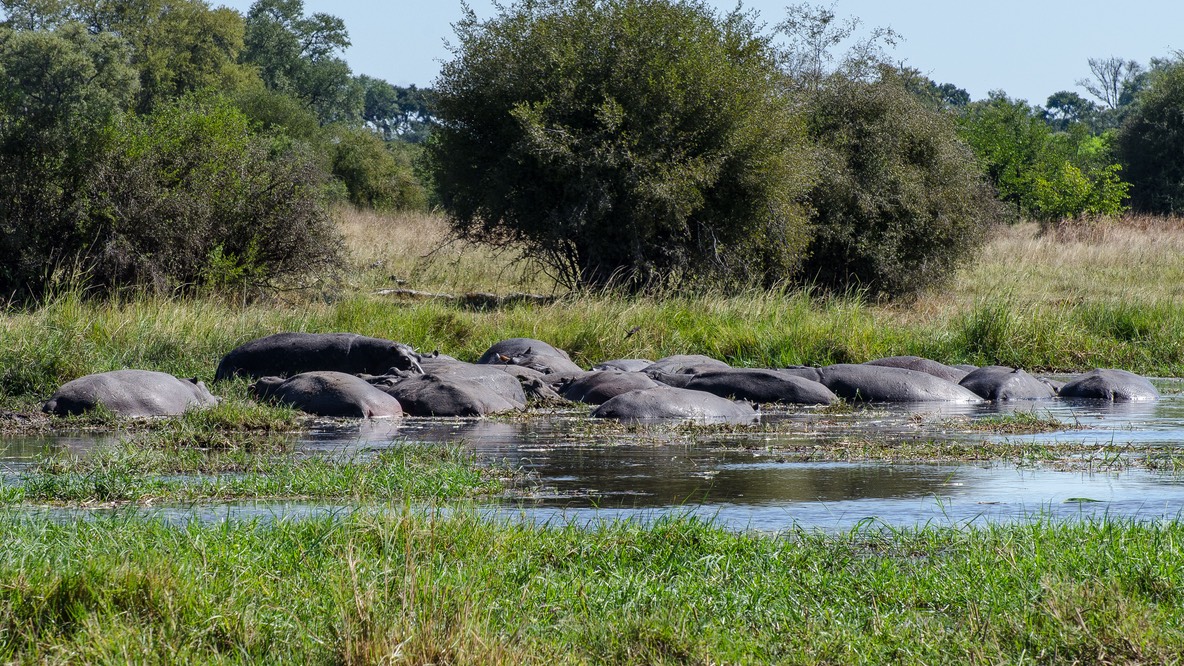
Before leaving Maun we stocked up with fuel and groceries and then headed northeast to the reserve. Our destination was about 150 kilometers away, all but the first 40 on some of the worst road we’d been on in a long, long time. We slogged along, then stopped for the night (pre-planned) at a wild camp spot about two-thirds of the way to our destination. Along the way we’d seen some elephants, so it was a nice drive despite the poor condition of the road. That evening we had elephants crossing through the area where we stayed. They really are delightfully charming.
The next morning we got up early — for us — and beat feet for the park, knowing we had a lot of area we wanted to explore and we only had two days to do it in. We found our campsite and then started out poking around. And it was totally wonderful.
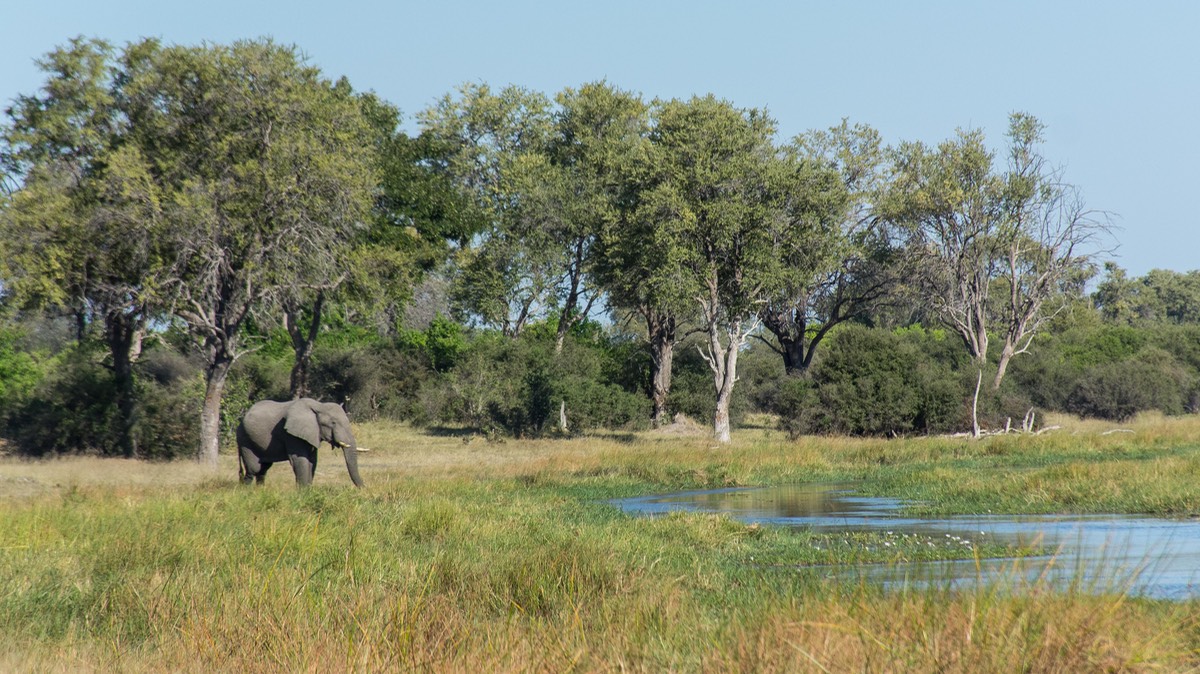
We didn’t try to keep track of how many of each kind of animal we saw. Elephants were everywhere — in the river, along the banks, in the brushy areas, and in our campsite. Super; but we also saw hippos, bunches of them: in the marshy areas, collapsed on the edge, swimming in the water; multitudes. They would be under the surface, covered with plant life; when they would come up for air they looked like they were wearing green May Day wreaths — or the Return of the Zombies of the Deep. Very cool.
And then there were the other animals — mostly black impalas, giraffe, zebras, kudus, warthogs, and waterbucks, too many of them to count. New for us were red lechwas and tsessebes. All of them just everywhere, and the lechwas are particularly beautiful creatures. We were in seventh heaven.
The nights were quiet and starry; the elephants would traipse through our site, on their way back and forth to the water. They didn’t pay much attention to us, either then or as we drove around the park — unless we either got too close or somebody in their group wasn’t paying enough attention. Once, an older female really gave a dressing down to a smaller guy who wasn’t stepping back from the road, and as a result trapping her too close to the truck. An angry roar, a waving trunk, and everybody moved to their proper place. We apologized, let them get to where they wanted to be, and slowly moved on around them.

We camped there for two nights and found pretty spots to stop for our lunch each day, with animals all around us. We kept getting lost, because there were far more paths we could try to drive than there were actually roads. It seems the animals don’t give a thought as to whether they were wandering on a vehicle road or an animal track. We did a lot of backing and filling, trying to keep upright and relatively scratch-free as we fought our way through the brush. It was glorious.
When our time was over, in a way we hated to leave, but actually we were ready. The roads in the area were in deep sand and really narrow; while Rick did just fine, it requires full attention all the time, and that’s wearing. By the end of each day, collapsing was just about all we could manage. So we faced eastward, made an especially lovely early morning drive through an area we’d not yet seen, and left the park to head back down to Maun.
Our first foray into the delta had been a complete success!
Arriving back in town, we were already totally missing “our” elephants. We settled in for several days, while we recuperated (Rick says “I’m not moving this truck”) and made plans for our next adventures. Parked near us was a nice fellow, John, an English writer living in Africa. We had lots of nice chats and he gave us good advice on what lay ahead, particularly about visiting Zimbabwe.

Zim, as the country is often referred to, can be a bit difficult, in part because it uses US Dollars as official currency. This is fine as far as it goes, but they can be hard to obtain locally; while we brought plenty along with us from the states (we think), getting proper change is difficult. Also, fuel is reported to often be scarce, and the quality sometimes unreliable. John had some good suggestions. For one thing, he said that if we had cash (US) we could get fuel without trouble. He answered our questions about what to see and do in Zim, we talked about the state of the world, our respective home bases, and why we were where we were today. He was a treat, and we hope to catch up with him at some point somewhere else.
And then we were ready to move on from Maun. By plan, we were now poised to circle around the western side of the Delta, and move on up toward the Botswana/Namibia border. Along the way, Kathy wanted to stop at a rock art site, the Tsodilo Hills. So north we went.

We spent the night at a bush camp we’d learned about that was back in the brush along the road leading to Tsodilo Hills. It was a quiet night, mostly. Mid-evening, we’d been hearing some faint murmurings in the brush, then suddenly there were a couple of determined “thumps” against the back end of the truck. No surprise — by now we were a little nervous. We looked out the back window, twitchy about baboons and perhaps even some unexpected human visitors. But no. As our heads appeared in the window, an elephant snorted a bit, backed up, and turned to leave! He’d been on his way to a local waterhole and wanted to know who was parked up for the night along his trail to the water. Wow! Delightful!

Archeologically speaking, “rock art” is the common term used for the remains of ancient peoples and their paintings and etchings on rocks in remote places, often in caves. For the people of the time, they were making a record of what they saw as they moved from one place to another, sometimes leaving directions on where to find water. They also were recording religious experiences, legends, ceremonies and the like. Most of what can be seen here is the work of the San people, although the Bantu tribes are represented as well.
There are various styles of rock art in different parts of the world, and what we can see today is a more fragment of what has been created since humans first existed. They are exciting to me, and I get a lot of pleasure in seeing them, wherever they are. We had a very good experience at the Tsodilo Hills site. I had a lovely guide who was bright, knowledgeable, and willing to let me go at my own pace. She and I had a nice chat, and I learned a lot about her and her life; she lives nearby, in Shakawe, and has been working as a guide here for 6 years. She was quite impressed with all the places we have visited, and we exchanged emails. I took some pictures, which I will send to her.
From there we stopped for a last couple of nights in Botswana, at the rather famous Drotsky’s Cabins, south of Shakawe, close to the border. It’s a delightful spot, right on the Okavango River as it moves into the delta. There’s an old, splendid lodge, and several campsites laid out under a huge canopy of trees. Lots of shade, very restful, tropical setting, and families of monkeys at play on the lawns and hanging from the trees. A real sweet spot.
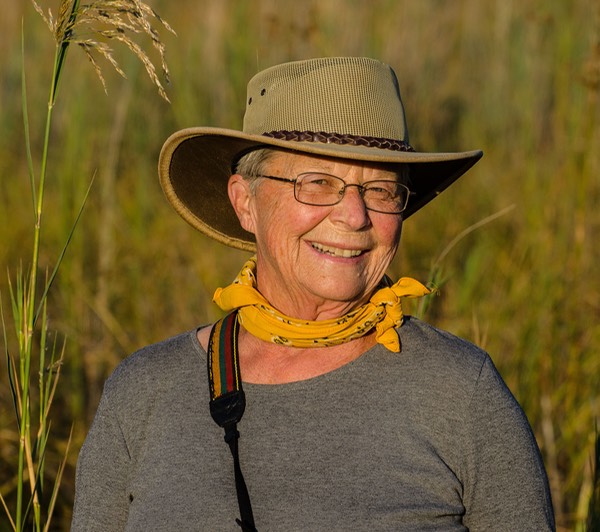
Knowing it was time to move on, but reluctant, we packed up the camp chairs for travel and headed for the border. In Shakawe, amazingly, we were able to pick up internet, and spent some time getting ourselves current. This was great, as we’d been unable to get on line for several days now. The crossing gave us no trouble, and suddenly we were back in Namibia, fulfilling a plan we’d made several months ago. You might remember we spent three months in Namibia last fall, left the truck there, and then flew back into the country at the end of February. During our time there we saw much of the country, but had left a narrow strip to be explored at a later moment. The moment was now!
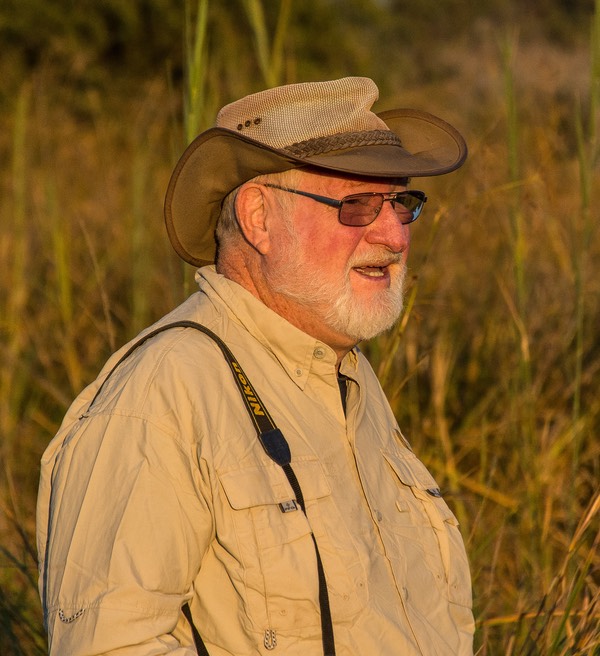
We had now returned to Namibia to check out this “narrow strip” — The Caprivi Strip or Zambezi Region — planning to move east across it as we made our way toward Victoria Falls. It’s a narrow strip of land that runs east-west across the top of Botswana, below Angola and Zambia. Historically, Germany traded with Britain for it along about 1890. Germany’s plan was to have a waterway that ran between the Indian and Atlantic Oceans, along the same lines as the Panama Canal. There were two real problems. The first was the logistical nightmare called Victoria Falls. The second was that Germany was defeated in 1918 and had to give up the strip of land. Anyway, it’s all histoire. Today it’s a rather poor, undeveloped section of land that has mostly figured in various squabbles as a part of the borders of Angola, Botswana, Namibia, Zambia, and even Zimbabwe. Given the total lack of roads across northern Botswana, the Strip also provides some access to the Delta from the north; we’ll return to that in a bit.
Lots of countries come together here. Tourists do, too, mostly at the eastern end of things, when they flock to see one of Africa’s biggest tourist attractions, the enormous Victoria Falls. We’ll get there in a couple of weeks. For now, we’re making our way among various parks and reserves as we meander towards a town called Katima Mulilo where we plan to cross into Zambia.

Our first needs in Namibia (true after crossing most borders) were fuel, internet, groceries, and an ATM. So we headed toward the small town of Divundu, which reportedly could take care of it all. Well mostly. We had some leftover Namibian funds from earlier, and were able to get to an ATM and add to that pile. A fuel stop was awaiting us, and two, count ‘em two grocery outlets added to our badly diminished supplies. We’d not had a store available since leaving Maun, five days earlier. They even had some ripe, fresh bananas. Goody. But internet? Nada. We would have to continue without any connection for the next week or so. So we headed on, across the panhandle which Rick immediately christened The Nullarbor of Africa (those of you who’ve traveled in Australia will smile in recognization), 200 kms of mostly straight nothing-ness, although we did see a couple of elephants in the distance at one point.
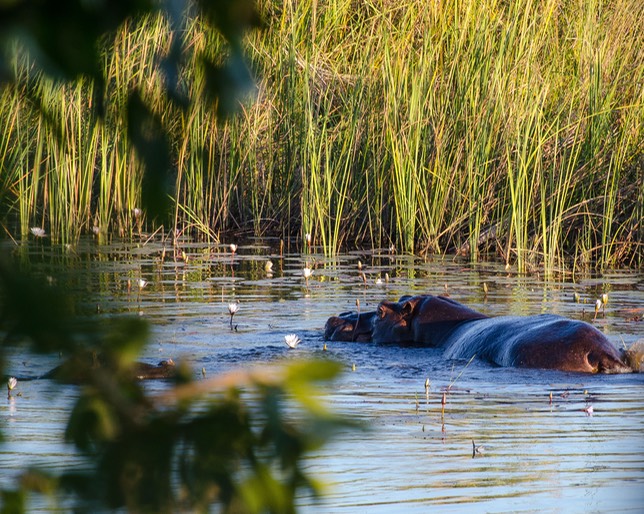
The nice thing was that crossing back into Namibia felt almost like coming home. Right away, at the fuel and grocery stop the locals seemed happier, more easy going, quicker to smile and to laugh. Rick visited with four really little kids in the car parked next to us. Each one wanted to say, “How are you today?”, in turn with their wonderful smiles. Not far away, and probably keeping an eye on the kids, a couple of women in front of a shop were enjoying the interaction. In the stores, the scene, while busy, gave off a happy vibe. That’s the thing about Namibia — the people are friendly, open and seemingly contented. We love it here.
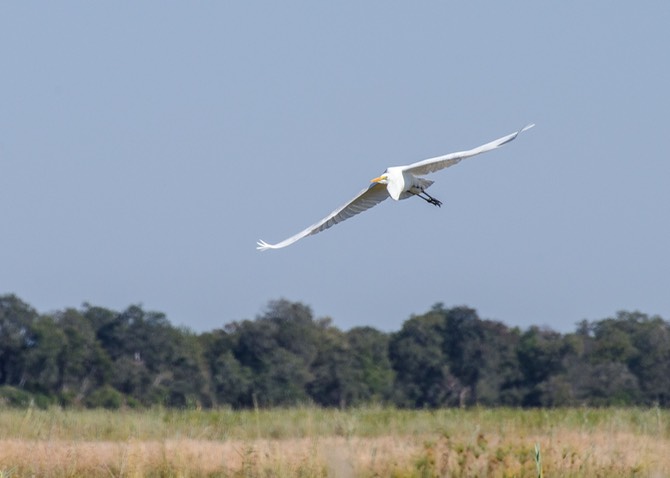
Later in the afternoon, now in the eastern part of the Caprivi, we crossed the Kwando River and reached the small town of Kongola, where we turned south, following the river, to a small locally owned campsite right along the water. It was beautiful. Calm and quiet, right on a side channel of the main river with just a few families living around. We had cows passing by and the chattering of chickens. Lots of birds. Lukas, the owner of the site, was charming and thoughtful; he and his wife and their kids made us very welcome. We stayed two nights, taking a walk in the morning and enjoying two incredible sunsets across the river. We were back in Namibia and in a much less touristed area and, after Botswana, the site was amazingly inexpensive.
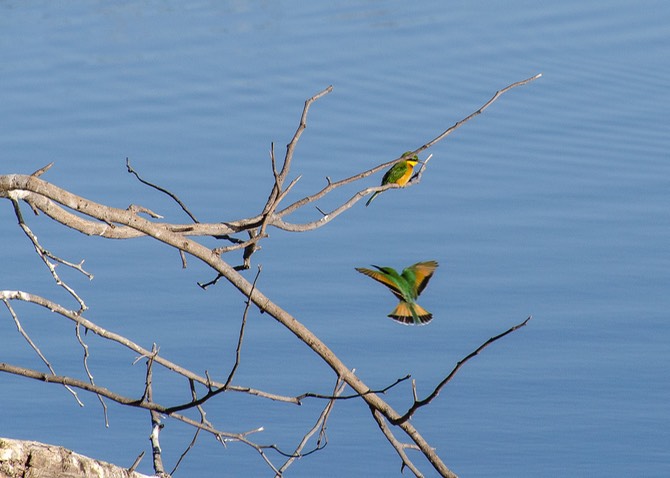
Leaving there, our plan was to move only about forty kms further south along the river to Mudumu National Park, on the northern edge of the Linyanti Swamp. Other travelers had told us we’d like this area at least in part because it would feel like a place out of Old Africa. Less crowded; less developed; less expensive; more in tune with our basic philosophy; Less is More. Were they ever right!

It was Sunday morning, so folks were out walking along the highway on their way to church. Not surprisingly they walk long distances; we could get a sense of that because we drove along for awhile with everyone walking the same direction we were going, and then realized that now they were walking towards us instead, and that continued for quite aways as well. All along, we only saw one other car; everyone was walking. There were lots of small communities of neat and tidy homes, but no cars to be seen.
After a time, we turned off the highway at a sign indicating “Hippo Pool” because, well, who wouldn’t? This side road took us into a beautiful world of savanna grasses, scattered trees, and eventually the river. No hippos there at the moment, but we saw a lone giraffe, an african fish-eagle and a marvelous white heron, all in lovely settings.

Mostly it was the quiet and stillness that we enjoyed. While not technically part of the Okavango Delta, it sure looks a lot like it to us.
Rather than retracing our steps back to the highway, Emily (our GPS) showed us that we could keep following the narrow tracks along the river and continue on to our destination for the day; so of course we did. There are only three campsites in Mudumu NP. Not campgrounds with multiple sites; just three sites completely separated from one another, each with its own access from the track we’d been following, each right along the river, each free but for the nominal daily fee for the park. So far as we know they cannot be booked in advance but are simply there to be enjoyed by whoever finds them.
So that is what we did. We stopped to check out the first one we came to and saw absolutely no reason to leave. Ever.
This is where you join us now. In the spot we describe at the beginning of this message.
Heaven.
Rick, Kathy & Tortugabeest, at home in the delta.
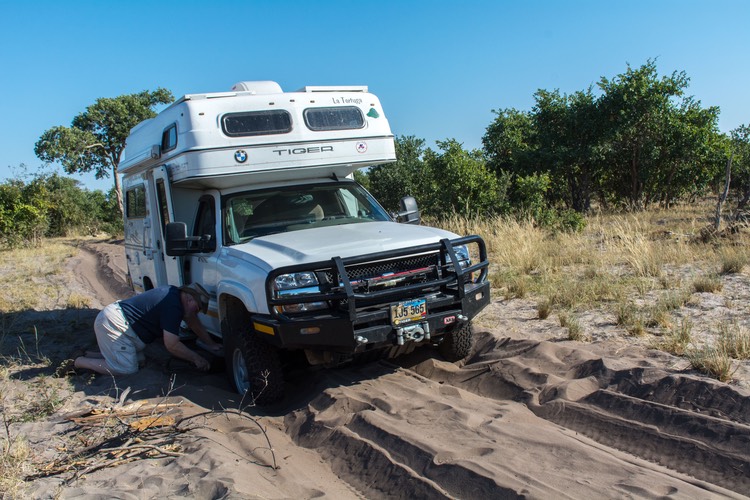
Ps: Well……
To borrow a line from John Denver, we really need to say,
“Almost Heaven…”.
Shortly after leaving our idyllic spot to begin heading for the border with Zambia, Rick managed to get the Tiger stuck in some deep sand. We got to use our sand ladders and our shovel — both for the first time — and with a little pushing help from a passing French couple and their safari guide we were on our way once again. Life is good.
Go to the Photo Page to see more pictures from this story